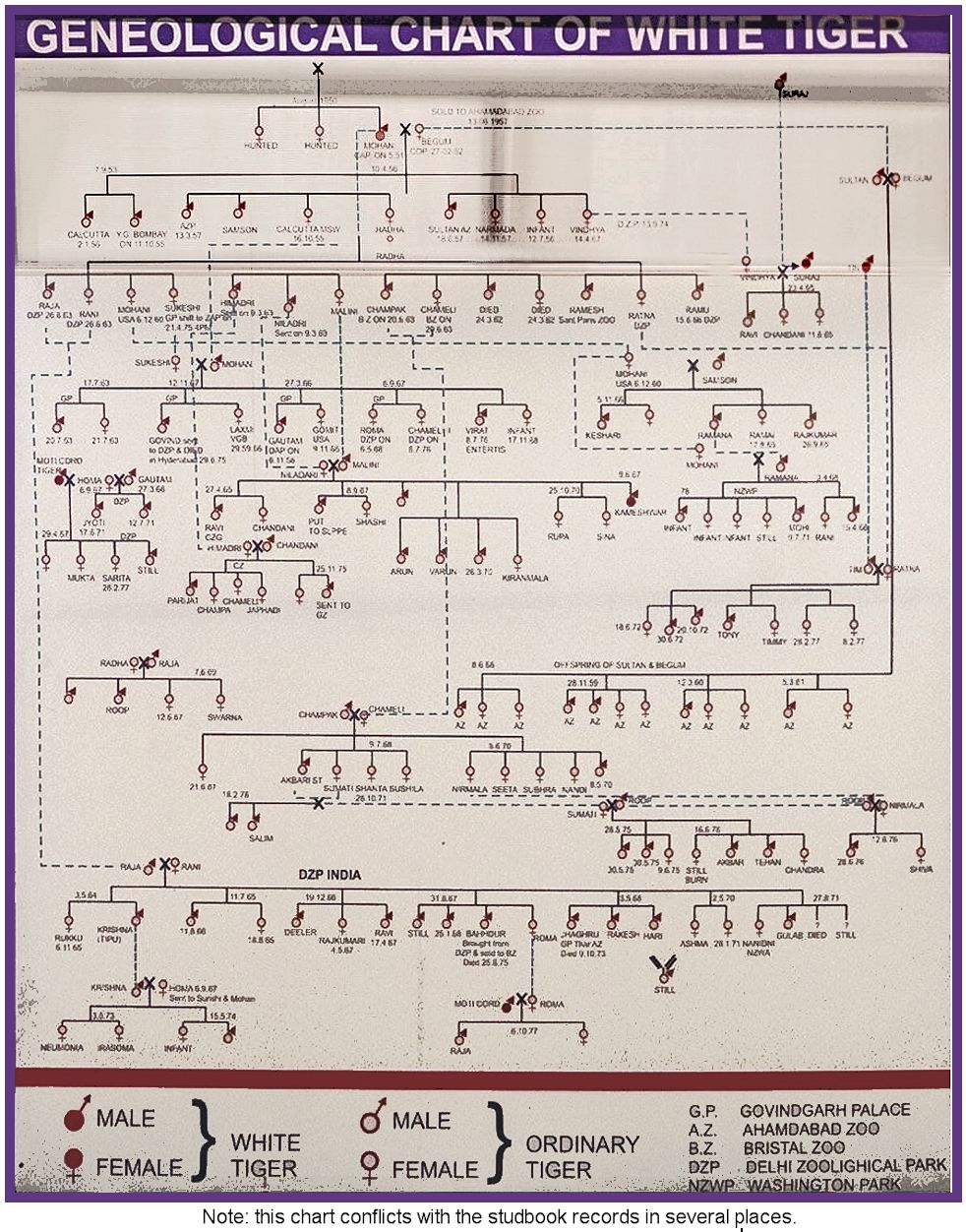
|
WHITE TIGERS 1950s TO 1970s - REWA, ORISSA, FIRST EXPORTS TO UK AND USA ZOOS |
Historical quotations are credited and are in the public domain. Original text is licensed under the GFDL. I am grateful to Paul McCarthy and Jerry Blackman for researching and providing extensive material, information and corrections on white tigers and for genealogies.
“White gene” vs “Inhibitor gene.”
Although these pages refer to “white genes,” white tigers have the genes for normal orange colours, but those genes are switched off by a recessive “inhibitor gene.” When a tiger inherits 2 copies of the inhibitor gene, the normal orange colour is suppressed. In general parlance, it’s simply easier to refer to “white genes.”
THE WHITE BENGAL TIGERS OF REWA
There were 8 cases of white tigers in Rewa State between 1909 and 1959. These were recorded in palace diaries and included a 2 year-old male captured near Sohagpur in December 1915 and kept for some years in captivity. The Maharajah Gulab Singh of Rewa captured this young male white tiger in December 1915 and it lived in captivity at his summer palace in Govindgarh until 1920 after which it was stuffed and presented to George V as a token of loyalty (it may still be in the British Museum today). HE Scott of the Indian Police described that animal in December 1920 in a Miscellaneous Note in the Bombay Natural History Society's Journal (account printed earlier on this page).
There was also a fine specimen of a white tigress in the Calcutta Zoo in 1920. The Maharajah was succeeded by Maharajah Shri Martand Singh who shot a white tiger in 1948 and then resolved to try to capture a white tiger. In May 1951, the Maharajah and his hunting party came upon a tigress with four cubs, including one white one, while hunting in Bandhavgarh, a jungle region of Central India (now a national Park, Bandhavgarh has "White Tiger Lodge"). The cubs were about 9 months old. The hunting party shot all but the white cub which his guest, the Maharaja Ajit Singh of Jodhpur, declined to shoot. The white cub, which appeared bigger and stronger than the others, escaped back into the jungle, but hunger drove it to a kill previously made by its mother. A cage was placed at the entrance of the crevice where the cub was hiding; when thirst overtook the cub it entered the cage and was trapped. It was transported to the Maharajah's palace where it was kept in a large, open courtyard. This tiger was the famous Mohan ("Enchanter"). He was unsuccessfully offered for sale for £10,000 in The New York Times and The London Times, on June 22, 1951.
Gerald Iles said the Maharaja offered Mohan to Manchester Zoo, suggesting he approached several zoos. A "Life" magazine article about Mohan from Oct. 15, 1951 was entitled "White Tiger: An Indian Maharaja Is Trying To Sell His Rare Cub To A U.S. Zoo." The Maharaja was 28, and the asking price was $28,000. Dealers estimated its value at $4000 and predicted a slow market. In July 1955, the world's only known white tigress was reportedly roaming the bamboo jungles of Vindhya Pradesh, Central India and was said to be the mate of Mohan (erroneously said to have been captured 2 years before). Few people had ever seen it and anyone who could trap would be able to name their own price (Los Angeles Times, July 31, 1955)
On February 27, 1952, a normal-coloured tigress, Begum, was captured in the area and was kept with the white tiger. Mohan was bred to Begum, but they produced only orange cubs (the Maharajah didn't know about recessive genes when he kept breeding Mohan to Begum.). Begum did not carry the white gene. Two male normal-coloured cubs were born on September 7, 1953, and of these one was given to Bombay while the other went to a Calcutta dealer. (Newspaper articles in 1955 said that Mohan fathered three cubs in 1953, not two, but this conflicts with the chart drawn up at Rewa. If there was a third surviving cub (carrying white genes) it is unaccounted for. I am inclined to believe “3” was a misprint in one newspaper, or by a news agency, which was be copied into other newspapers.)
Mohan and Begum's second litter of four normal-coloured cubs was born on April 10, 1955, consisting of two males and two females. A male and a female cub of this litter went to a Calcutta dealer, and one male cub was given to the Ahmedabad Zoo. The remaining female cub was kept at Rewa and later bred to Mohan. A third litter was born to the white tiger and the normal coloured tigress on July 10, 1956 and two female cubs were presented to the President and the Prime Minister of India, and went to the Zoological Park in New Delhi while a male cub along with its mother went to the Ahmedabad Zoo. These normal coloured cubs were heterozygotes. The Birmingham News, Alabama, 27th July, 1958 (p84) and several other papers stated that a white tiger was born at the Ahmedabad Zoo, a grandson of the only white tiger in Rewa State. The mother had to have been the orange female heterozygote born in 1955, and the father had to have been No. 3 or Samson.
Chart 01a: Mohan, Begum and Offspring at Calcutta Zoo (large image, opens in new window)
Chart 01b: Mohan, Begum and Offspring at Ahmedabad Zoo (large image, opens in new window)
Chart 01c: Ratna (Mohan's daughter) and Jim (large image, opens in new window)
The Maharajah of Baroda said "Rewa was frustrated. I told him the answer, incest of course". Mohan was then bred to his daughter Radha, resulting in 4 white cubs on October 30th, 1958: Raja ("ruler" or "king"), Rani, Sukeshi and Mohini ("Enchantress") that carried 75% of Mohan's genes. Radha continued to be mated to Mohan. In 1960, Radha produced Malini (tawny female) and Nildari and Himadri (white males). In 1965, Malini and Niladri produced Ravi (white female) and in 1969 they produced 4 white cubs: Arun, Barun and an unnamed male, plus a female called Kiranmala. Later litters produced only 2 white cubs: Rupa (female) and Subhas. Himadri and Chandana produced 20 white cubs, though only 4 survived long term: Sefali, Tara, Hira and Himadri Jr. Calcutta Zoo sold female white tiger Sefali to Gauhati Zoo. According to Gee, 2 sisters of Radha went to the New Delhi Zoo who may not have known they were heterozygotes. An orange female from Mohan and Radha's second litter was supposed to have gone to New Delhi Zoo, but went to Calcutta Zoo instead in exchange; Calcutta Zoo did not honour the part of the exchange requiring a share of her offspring. To introduce new blood into the white tigers at Calcutta Zoo, Chandi was mated with an orange "Burmese" tiger, called Bhanu.
Regarding Malini going to Calcutta Zoo, K.S. Sankhala said that she "was supposed to go to Delhi Zoo." He became bitter about this and made his grievance with Calcutta Zoo public even though New Delhi Zoo already had several tigers with the white gene.
Radha/Mohan matings ultimately produced 13 white cubs and 9 orange; she died in 1974. Raja was also mated to his mother Radha and the pair produced a male white cub named Roop who was traded to Bristol Zoo for a white female named Seeta. Mohan died in 1969, aged almost 20. He was the last recorded wild-caught white tiger and the first Bengal tiger to be registered in the International Tiger Studbook at Liepzig Zoo.
After the Maharaja of Rewa was finished using Begum, the wild orange tigress bred to Mohan, in his tiger breeding program she was sent to live at Ahmedabad Zoo. Her second mate was her unnamed Begum-Mohan son “Indian Studbook No. 3” and her third mate was the Begum-Mohan son Sultan. She was bred to "No. 3" and Sultan even though she did not carry the white gene. This occurred after the Maharaja had sent them to a zoo (Begum could not be returned to the wild). This more-or-less proved Begum did not have the white gene, but, if she had, the Begum-No.3 and Begum-Sultan matings could have led to heterozygotes in the zoo population of Bengal and generic tigers. Roychoudhury’s articles mentioned "surprise births" of white tigers in India in the Asian circus and various zoos. Since these were not claimed to be an unrelated strains they most likely came from the heterozygous cubs produced early in the white tiger breeding programme and lost to follow-up.
Chart 01d: Begum and Sultan Test Matings and Offspring (large image, opens in new window)
Chart 02.5: Mohan's Line at Hyderabad & Mysore (large image, opens in new window)
The Indian Tiger Studbook and the International Tiger Studbook contain numerous discrepancies and both are considered authoritative sources. There are also discrepancies between the chart at the museum in Rewa and the studbooks. This is the information from the Indian Tiger Studbook, which is more likely to be correct.According to the Indian Tiger Studbook "No. 3" (an unnamed male), not Sultan, sired Begum’s 1958 litter. The International Tiger Studbook says the sire of that litter was Sultan, although his birthdate means he was not sexually mature. “No.3” was born in the same litter at Radha and Samson (1955). Neither Samson nor the unnamed female in that litter are in the Indian Tiger Studbook.). Samson was acquired from Ahmedabad Zoo for the USA by Ralph S. Scott. “No. 3” was sold to an animal dealer in Calcutta and moved to Ahmedabad Zoo on March 13, 1957 where he died in 1959. He became a father on March 8, 1958 to one male, Studbook No. 7, and two females cubs, Studbook Nos. 8 & 9. The mother was Begum (Studbook No. 1.)
An unnamed female of unknown origin (Indian Tiger Studbook’s No. 53) went from Veemata (Bombay Zoo) to Ahmedabad on June 30, 1967 and died there on Feb. 25, 1978. She had no offspring. If this was the Mohan-Begum female born in 1955 she would have been 23 years old – possible, but unusual.
Sultan (Studbook No. 6 born in Rewa in 1956) became a father on Sept. 28, 1959 to male No. 15 and three female cubs, Nos. 16,17, and 18. The mother was Begum Studbook No. 1.
On March 12, 1960 Sultan x Begum had one male No. 19, and two females 20 and 21. There is no information regarding names or fates of the cubs.
On March 5, 1961 they had a litter of one male (who died on August 20, 1969 at Ahmedabad Zoo) and a female cub (who died on Oct. 25, 1966).
Begum was transferred from Rewa to Ahmedabad Zoo on June 13, 1957 and died there on Sept. 3, 1969. Sultan was transferred to Ahmedabad Zoo at the same time and he died there on August 4, 1969. Samson went to Washington DC in 1963. Samson, and Begum’s cubs from 1953, are not in the Leipzig Zoo studbook as this did not start until 1966.
According to the Indian Tiger Studbook one of Begum's cubs at Ahmedabad Zoo was a white tiger – this is how they recorded white gene carriers. Ahmedabad Zoo had white gene carriers only, no actual white tigers.
The Indian Tiger Studbook says that Ramesh went to New Delhi Zoo and died there on January 28, 1986 aged 22 years, but he went to Paris Zoo as a state gift to France and died there.
One of the Tiger Studbooks showed two tigers as No. 9 – one male and one female. One is Suraj (male, should be No. 45) who was wild caught and bred with Vindhya No. 5. They were the parents of Ram No. 34. The other “No. 9” is the female offspring of "No. 3" and Begum at the Ahmedabad Zoo in 1958. The error made it appear that Suraj was Begum’s son.
The genealogical chart for white tigers on display in Rewa contradicts the studbooks. According to the chart, the 1958 litter was fathered by Sultan (who was only 19 months old – males are usually not sexually mature until 4 years old) and the 1959 litter comprised two males and two females, contradicting the studbooks. On the chart the first male tiger cub born in 1953 went to "Calcutta". The second cub went to V.G. Bombay. In the 1955 litter the unnamed female and male (No. 3) tiger cubs bought by "Calcutta MSW" (Ministry of Social Welfare, part of the government of West Bengal) for Ahmedabad Zoo. Two male white tiger cubs (Hamadari/Himadri (No. 23) and Neeladari/Neeladri (No. 24)), were purchased by the government of West Bengal for Calcutta Zoo (Calcutta is the capital of West Bengal). They were named by the Governor of West Bengal. The purchase price was repaid by the zoo to Calcutta MSW by charging a separate admission fee to see them. Their female orange sibling, Malini No. 22, was property of New Delhi Zoo, and was traded for a pair of exotic geese to Calcutta Zoo. The New Delhi Zoo was promised a share of Malini’s offspring, but this was not honoured by Calcutta Zoo and was possibly not in writing.
The genealogical chart in Rewa does not show any tigers going to Calcutta Zoo, and it contradicts the studbook by saying that Ramesh went to Paris Zoo. It seems to show final destination and omit intermediaries.
Naturalist EP Gee described Mohan as "an exceptionally large and powerful beast, with a fine coat and ruff, with ground colour of almost pure white or off-white. There seemed to be no trace of brown, lemon, or even cream colour. The stripes were ash-coloured. The eyes appeared to be icy-blue, and the pads of the paws pink. ... The cubs appeared to be exact replicas of the father, and therefore need, no description. All appeared to be in perfect health, and a striking contrast to their richly-coloured mother [Mohan's daughter]. All five animals behaved as would be expected of tame animals in a zoo." Gee had been invited to examine the Rewa white tigers following the mating of Mohan to his daughter. At this time, the chinchilla mutation was erroneously believed to be a form of albino. Gee described the varying degrees of whiteness as ranging from light-coloured tigers with dark brown stripes ("red tigers") and cream-coloured ones with dark brown or dark grey stripes, through to white tigers with ashy-grey stripes. He noted that preserved skins of white tigers often faded to a cream background with dark brown stripes.
Professor JBS Haldane, one of the world’s leading geneticists in the 1950s, wrote of the breeding of albinos that albino mated to albino produced only albinos; albino mated to normal almost always produced "normals" (the inverted commas denote heterozygotes (carriers)), but those "normals" could be mated to albinos or to other "normals" to produced albinos and more "normals". EP Gee applied this theory to the Rewa white tigers and wondered if mating Mohan to his daughter would again produce only white cubs. Haldane advised Gee that the white tiger gene was a "recessive mutant" in which case the mating should produce equal numbers of white and "normal" cubs. In the 1950s, the chinchilla mutation (which is what white tigers really have) was unknown, luckily chinchilla is also recessive and follows the same rules as albino.
Bristol Zoo acquired an orange daughter of Mohan, and this is documented in Geoffrey Schomberg’s “The Penguin Guide To British Zoos,” (Penguin 1970 ISBN 0-14-146154-X). E.P. Gee said that Bristol Zoo acquired one of Mohan and Begum’s female cubs as a mate for Champak "to reduce inbreeding" but if she bred the offspring were unrecorded. The Maharaja of Rewa gave an orange son of Mohan, Ramesh, to the President of India, who made it a state gift to France. It resided at Paris Zoo, where it fathered several litters. It has no living descendants today. Paris Zoo did not know it carried the white mutation and made no attempt to breed white tigers from it. Two orange daughters/grand-daughters of Mohan went to Romanshorn Zoo, Switzerland. They were 2 sisters of Ram (born at New Delhi Zoo 23rd March 1965 and went to went to the Trivendrum Zoo) to Vindhya, daughter of Mohan and Begum, and an unrelated tiger named Suraj. The 2 sisters were born 22nd Feb 1967 and had a 50% chance of inheriting the white gene. They do not seem to have contributed to the white tiger gene pool. Mohini later went to America to found a line of white tigers there. Raja and Rani, were given by the Maharajah to the Indian government for the New Delhi Zoo, in exchange for subsidization of his breeding program and a share of their offspring. When they arrived at New Delhi Zoo, Rani was already pregnant. Raja and Rani's names translated as king and queen, though this was coincidental.
In 1964 Raja and Rani produced two white cubs, a male and a female. Rani mauled both, killing the female. The surviving male, Tippu, lost his tail and was hand-reared with difficulty. In 1965, Rani had two white cubs, but both died due to neglect. Rani had a second litter in 1965, this time producing three white cubs. She reared them for one month, but then lost interest. The female died aged 17 months and the male died of heatstroke in 1967 during shipping to the USA. Raja and Rani produced 20 cubs, all white, though Rani was not a good mother. Sukeshi was retained for breeding with Mohan. When Mohan was retired from breeding, Sukeshi was to be mated to her own son, but he showed no interest in mating with her and after 6 unsuccessful years Sukeshi went to New Delhi Zoo where she remained until her death in 1975.
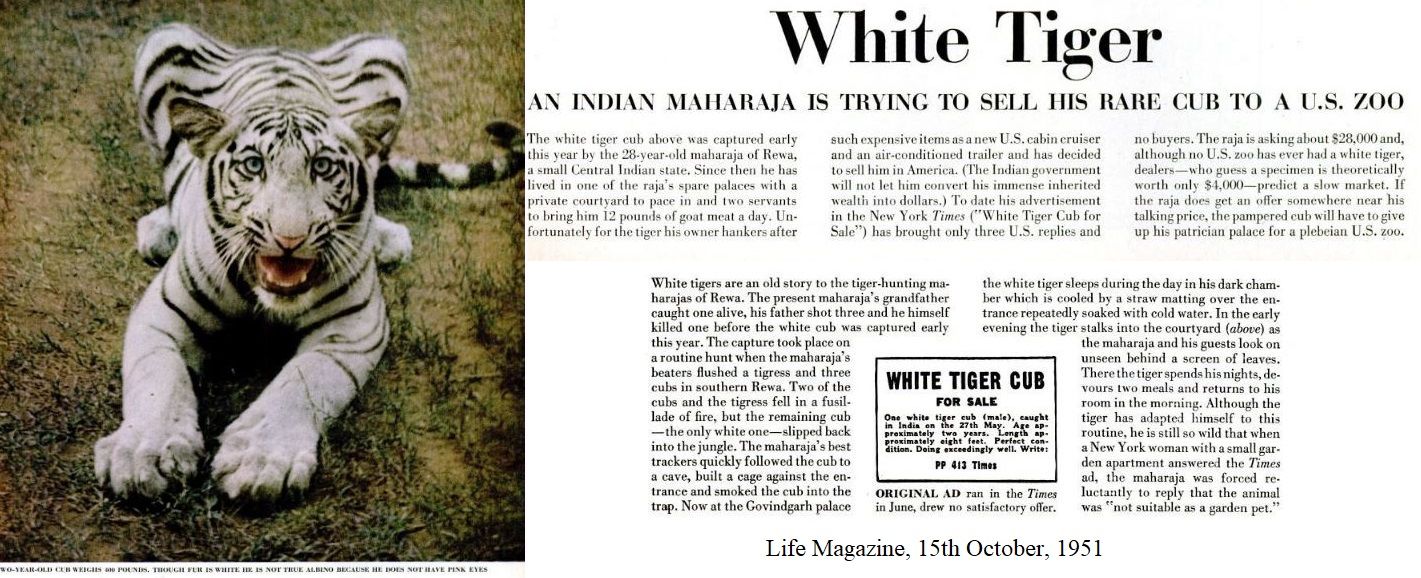
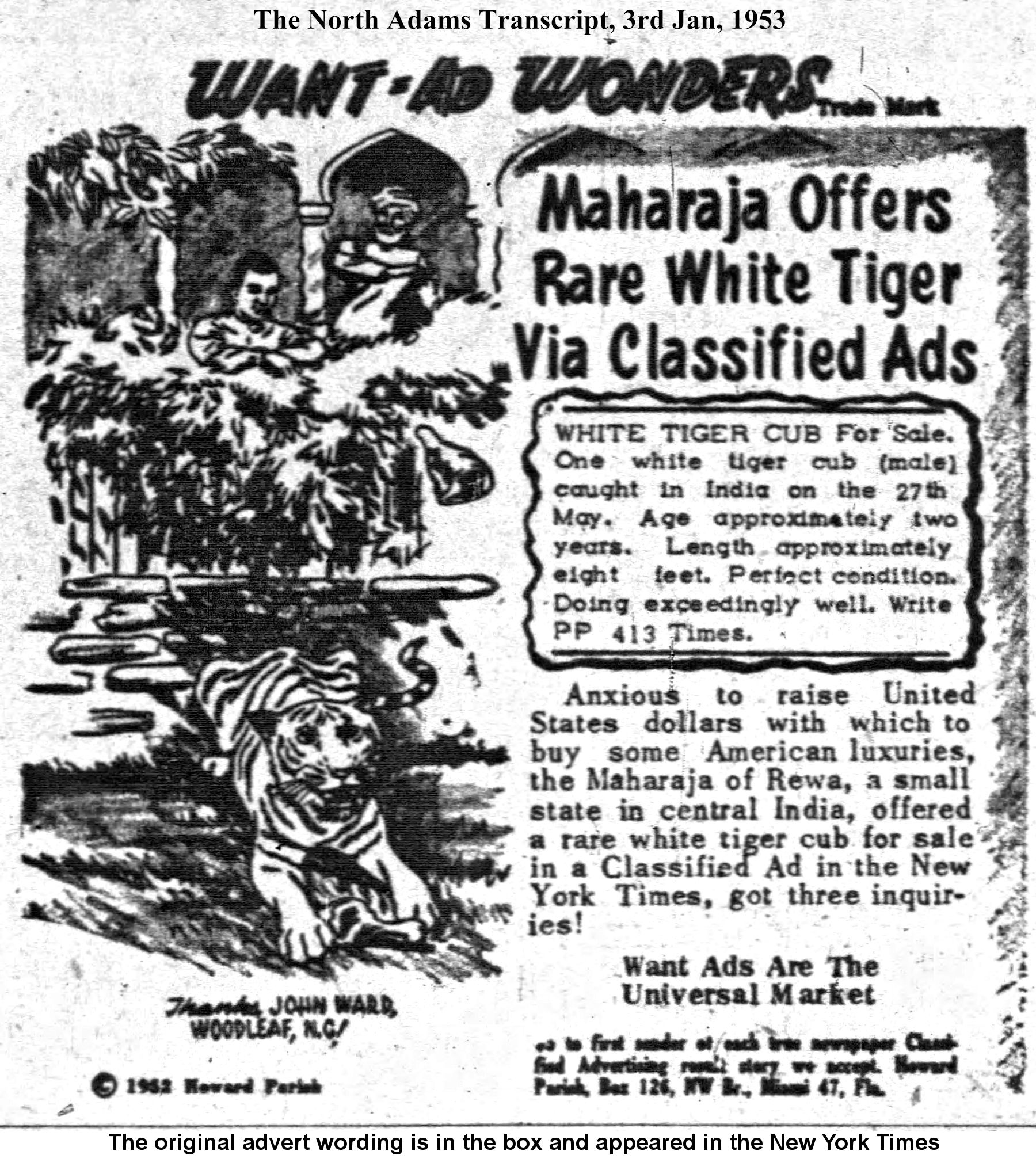
In the Amarillo Texas Sunday News Globe, 14th December, 1952 there is this report: ”White Tiger cub for sale, approximately two years old male caught in India on 27th May (1951) in classified ad in The New York Times got three inquiries.” The Los Angeles Times, 31st July, 1955 (p 57): "American buyer is refused offer of $92,000 for white tiger. The Indian government refused to allow its export. The world's only known white tigress is roaming the bamboo jungle in Vindhya Pradesh in Central India. Few people have seen the tigress a beautiful animal with glossy snow white fur has black stripes."
After the Maharajah successfully bred white tigers, which he housed in Govindgarh Palace, the Indian government banned the export of white tigers, declaring them a living treasure. EP Gee, a strong advocate of captive breeding for conservation, recommended that Govindgarh Palace, and its tiger occupants, be made a national trust. The Indian government took an interest in white tigers, banning their export on the grounds of concern over their survival. The Indian Parliament used to hear reports on the white tigers. When Eisenhower visited New Delhi in 1959, a white sister of Mohini was brought from Rewa to show him. In 1960, the German-American billionaire John W. Kluge bought a white tigress from the Maharajah for $10,000 as a gift for the US National Zoo (NZP) in Washington DC, but the government of India would not let it out of India. Negotiations included President Eisenhower appealing to Prime Minister Nehru to release Mohini from India. Finally Mohini was officially presented to President Eisenhower on the White House lawn. Tiger trainer Clyde Beatty also bought a white tiger from the Maharajah for $10,000, but was not allowed to take it out of India, and his money was refunded. TH Reed negotiated on Beatty's behalf. Mohini was a great attraction and the zoo wanted to breed more white tigers. Beatty had apparently originally tried to buy Mohan from the Maharaja of Rewa in 1951 ("Beatty Makes Offer For White Tiger Cub", Reading Eagle Oct. 25, 1951).
The story of Mohini and her descendants is at:
Mohini - Mother of American White tigers - and her Descendants The Miami Herald Wednesday March 9, 1960 Page 36 “White Tigers Leap On Film Of The Scotts” reported that Ralph and Yvonne Scott were showing a film they made of the white tigers of Rewa the previous winter to guests in the Green Room of the Surf Club. The guests include Clyde Beatty the lion and tiger tamer, and owner of Jungle Land, and Zsa Zsa Gabor. This was accompanied by a photo of Yvonne Scott holding a white tiger cub.Ralph S. Scott, who was instrumental in bringing Mohini to the United States, said that at one point the United States Ambassador to India had her placed in an Embassy truck with Marine guards, because of all of the difficulty they were having getting her out of the country. Prime Minister Nehru of India had wanted the first white tiger to be exported from India to go to Beijing Zoo, and not Washington DC. One of the events that influenced Mohini's fate was developments in Tibet, which resulted in the Dalai Lama fleeing from the Chinese to India. A wave of anti-Chinese sentiment swept India and Mohini went to the US National Zoo instead. The thing is Dr. Theodore H. Reed, the director of the National Zoo, had spent 6 months in India trying to cut through the red tape. TH Reed had been given a free choice and could have chosen Sukeshi, Raja, Rani or Mohini, for the Washington Zoo. Reed was also a paid agent for Clyde Beatty the tiger trainer, and he also bought a white tiger from the Maharaja of Rewa for $10,000, but this white tiger couldn't be brought out of the country, so the money was refunded. Scott was a big game hunter who had discovered white tigers on his way home from Nepal when he was a guest of the Maharaja of Rewa; he acquired an orange Bengal tiger named "Uncle Samson" (a cub of Mohan and Begum, and carrier of the white gene) as a mate for Mohini in 1963.
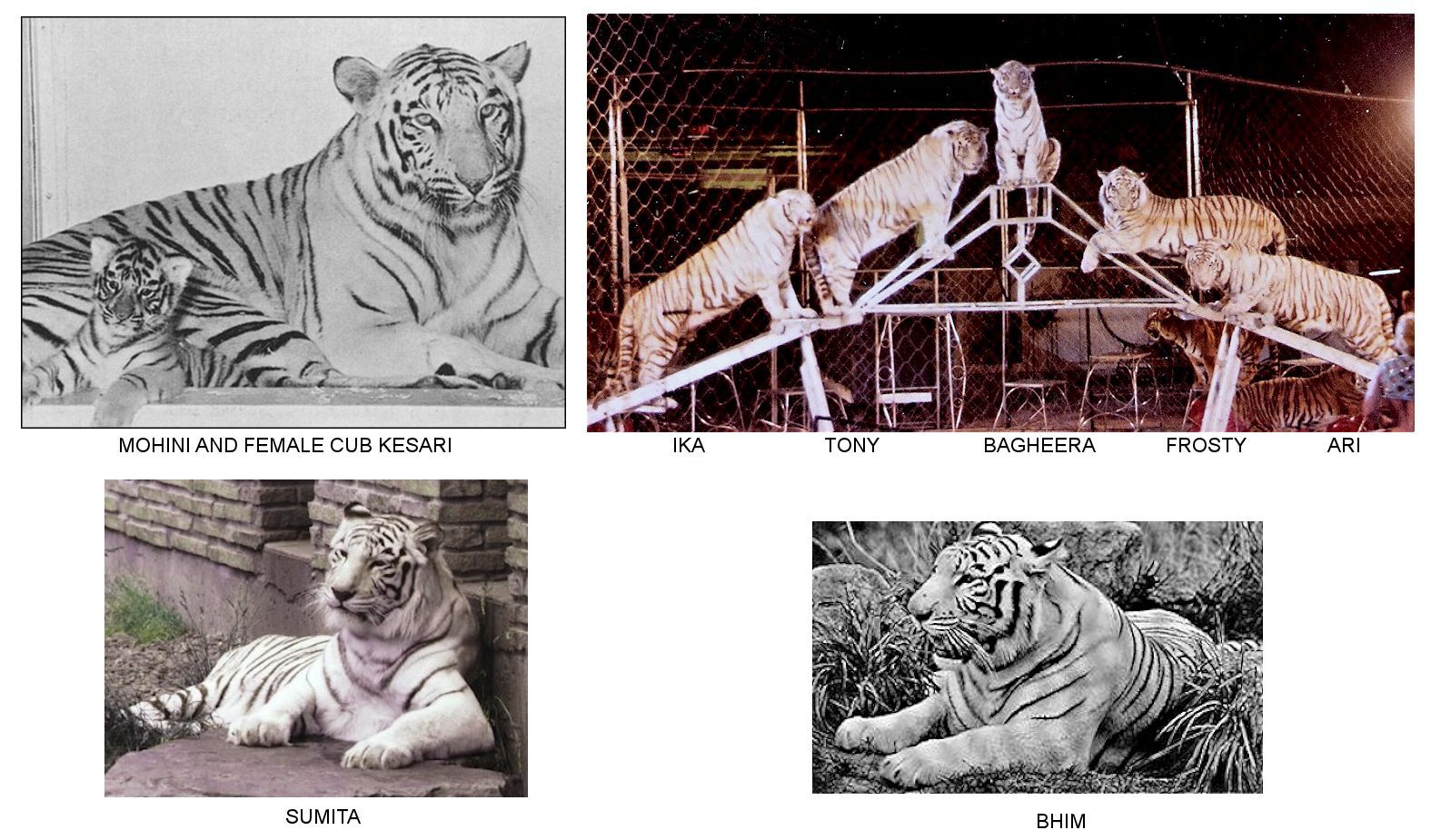
Patricia Hunt was also instrumental in bringing Mohini to the USA. In "Life" magazine Vol 56, No 6, Feb 7, 1964, the "Editor In Charge Of Whales, White Tigers, and Sifakis" column by George P Hunt (no relation) wrote "[Patricia Hunt] once found a story in the ad columns of The New York Times, in which an Indian maharaja was offering white tigers for sale. Her cables and her interest resulted in the sale of a white tiger to a U.S. zoo, for which the maharaja was duly grateful." The Waynesboro Record Herald, 15th February 1964 reported “White Tiger cub worth in a swap? Fred Ulmer the Curator of Mammals at the Philadelphia Zoo wants a six week old white tiger cub.” This could only have been Rajkumar.
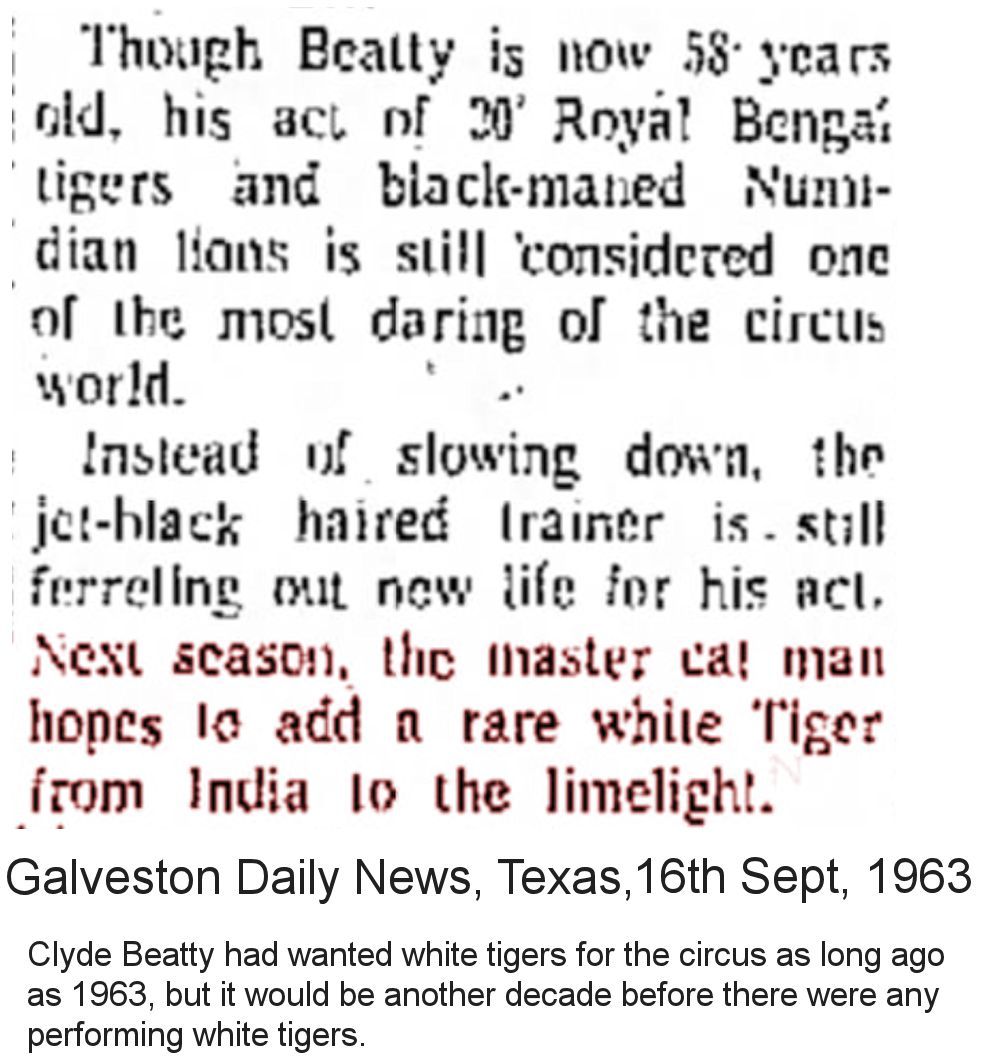
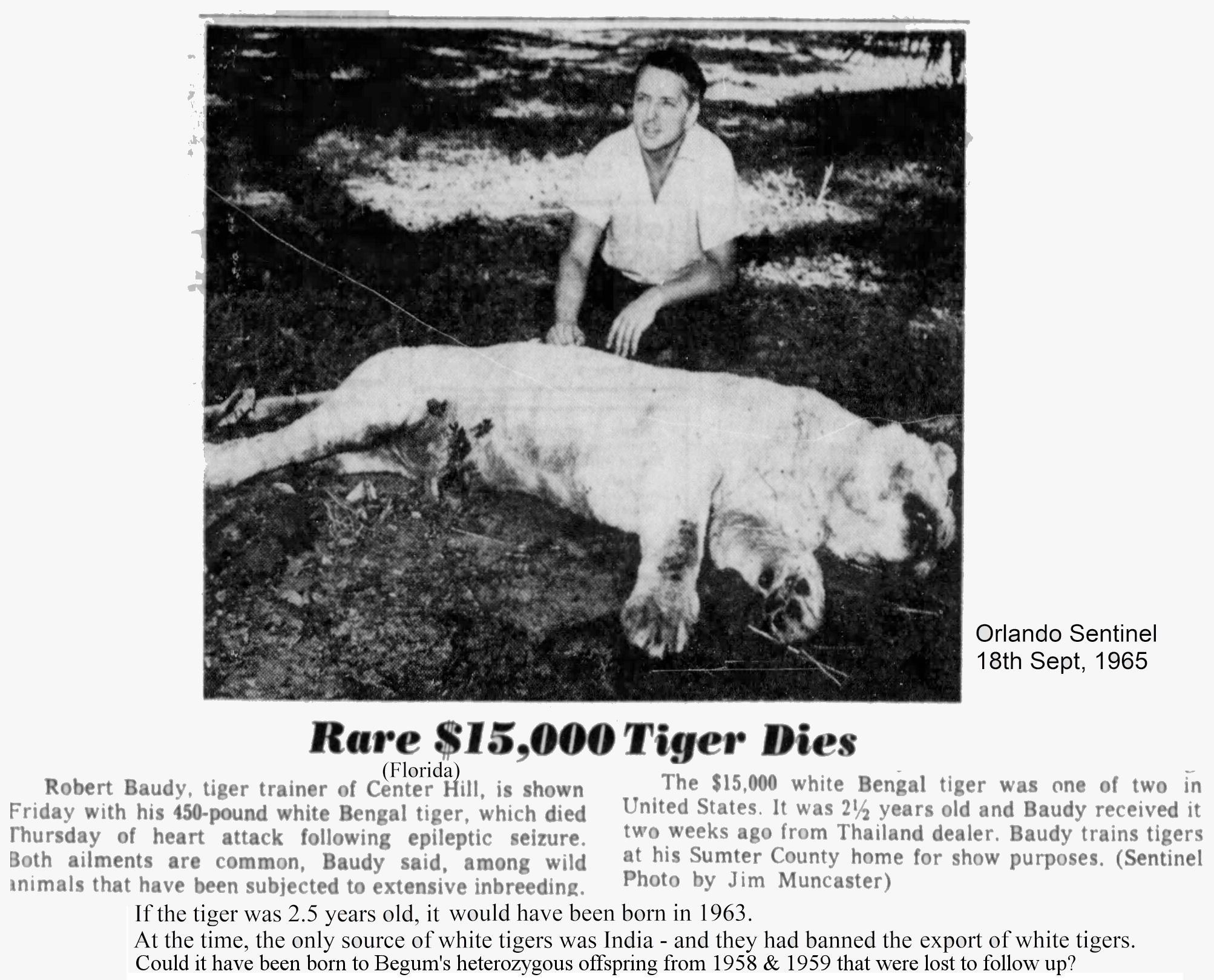
Ralph S. Scott brought back at least two wild caught orange tigers for loan to the National Zoo, including a male named "Mighty Mo", who was paired with Mohini for breeding, without success, so he was replaced by "Uncle Samson" from Ahmedabad Zoo. Mighty Mo is not in the studbook and was was later transferred to Pittsburgh Zoo. Because no more white tigers were being allowed out of India, NZP successfully mated Mohini to Samson.
Ramana and his orange sister Kesari had a litter of three white tiger cubs, and one orange, at the Cincinnati Zoo on 20th June 1974. These four cubs were the last (studbook) registered (pure-bred) Bengal tigers born in the Western Hemisphere. By co-incidence circus tiger Sheba II, descended from heterozygous Susie (on orange tiger believed to be a descendant of Mohan) had a litter of two white and one orange at the Baltimore County Fair on the exact same day.
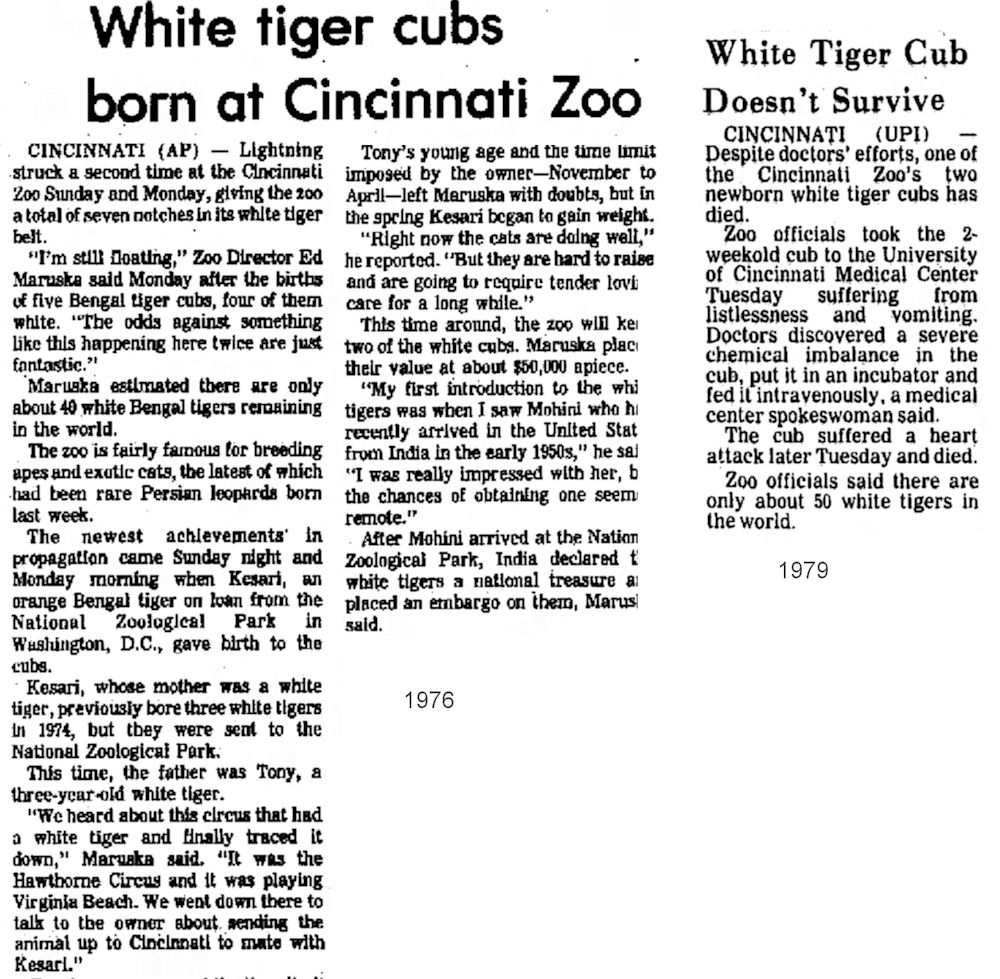
Chart 03: Mohan's Line via Mohini in the USA (large image, opens in new window)
In spite of the agreement with New Delhi Zoo, because of the expense of keeping the white tigers the Maharajah threatened to release them all into the forest. As a result he received permission to sell two more pairs to foreign zoos. A brother and sister pair, Champak and Chameli, went to Bristol Zoo in 1963 at a cost of $10,000 each (£7,000) where they produced several litters, all white. At one point Bristol Zoo held one third of the entire global captive population of white tigers. The Cincinnati Zoo tried to buy a white tiger from Bristol Zoo in the early 1970s and got nowhere; also Glasgow Zoo also wanted a white tiger from Bristol Zoo, but was also refused. The elderly white tigress that died in Dudley zoo around 1985 was the last living pure Bengal descendant of the original white brother-sister pair sent to Bristol Zoo from India. Bristol’s remaining tigers were not pure Bengal tigers. The story of White Tigers in Britain is at:
White Tigers in British Zoos (1960s to Recent)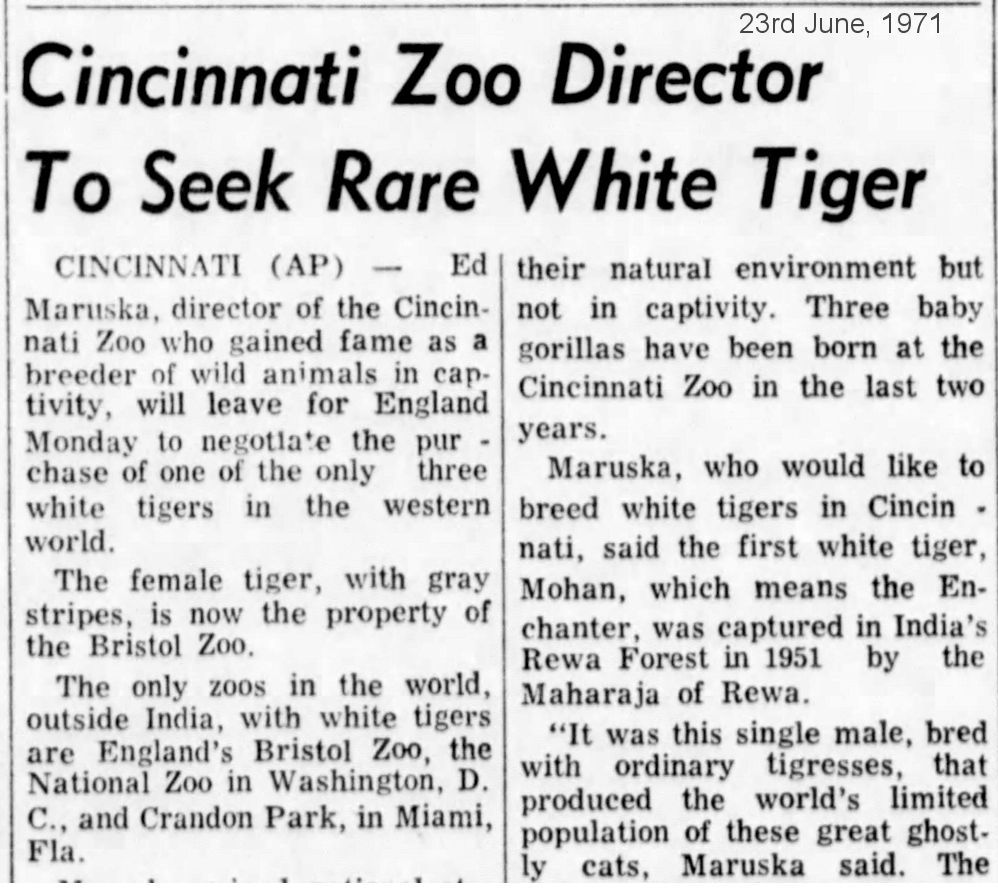
Ramesh, an orange brother of Champak, Chameli, Roop, and Mohini, was given to the President of India, by the Maharaja of Rewa. The President of India made him a state gift to France. He went to the Paris Zoo, the "Jardin des Plantes", where he had offspring, but they were all infant mortalities. The Paris Zoo did not know he carried the white gene.
Tiger trainer Charlie Baumann was approached, while performing at the Garden in New York City, by a Mr. Walton (British-born secretary to the Maharaja of Rewa) who was on vacation there. Walton invited Baumann to travel to Rewa as the Maharaja's guest in the hopes of selling him white tigers. Baumann was unable to accept. The handwritten note from Walton to Baumann on the Maharaja's own stationary is now in the collection of Wade Burck since 1984. While visiting New Delhi Zoo, Marshal Tito, President of Yugoslavia, saw white tigers in New Delhi Zoo and requested some for Belgrade Zoo, but was flatly refused by the Zoo.
Hill Garden Zoo in Kankaria was started by Reuben David in 1951. David was fascinated with freaks, hybrids (such as zebroids) and albino animals. He once refused the offer of a white tiger because it was not a true albino. (“Zoo and Aquarium History - Ancient Animal Collections To Zoological Gardens,” edited By Vernon N. Kisling, Jr., 2001)
Another pair was sold to Ralph S. Scott who intended them for permanent loan to the Crandon Park Zoo in 1967. The male, Ravi (renamed Rajah) died in transit. Although some accounts mention Kanpur Railway, according to Ralph S. Scott "They had a heat wave at the airport and if he had just made it on the plane." A Miami Herald article from April 18, 1967 - the day after Ravi II/Rajah died says: "The tiger was riding in a truck" which suggests he was on his way to the airport when he died. Kanpur is hundreds of miles away from New Delhi, where Ravi II/Rajah was born, so references to the railway station seem to be erroneous. It seems he died en route from New Delhi Zoo to the airport. According to the Miami Herald, the female Gomti (renamed Princess) arrived at Crandon Park Zoo on Saturday Jan. 13, 1968. An article dated Jan. 12, 1968 says that she was expected to arrive on Eastern Flight 21 from New York. Ralph Scott had first seen the white tigers of Rewa while tiger hunting in India. He bought these two white tigers for $35,000 each. The white female, known as Gomti in India, but Princess in America, only lived about a year in Miami and apparently succumbed to an infection. According to the Miami Herald article dated April 12, 1967, "Rajah [ie. Ravi II] was worth $25,000. But a heat wave apparently took." Scott later gave the name Rajah to the white tiger he bought for $38,000 in 1970, but which never arrived (there had been a bidding war between Scott and several others for this tiger). In a Miami Herald article from Dec. 1, 1960, Scott referred to Mohini (of Rewa) as "Princess" and said that Mighty Mo, her intended mate, was in the cage next to her. Mighty Mo had been captured in central India in 1959 as a cub. He was then exhibited at various branches of a restaurant chain before being formally presented to the National Zoo by J. Willard Marriott, Sr.
Scott was the President of the Zoological Society of Florida and he retained ownership of Gomti/Princess who was on permanent loan to Crandon Park Zoo. Gomti/Princess was the daughter of Mohan and Sukeshi and was Mohini's half-sister; she may have been intended to breed to a cub of Raja and Rani (her first cousin). He didn't want to breed Gomti/Princess with any of the zoo's resident tigers. He was determined to get a white tiger mate for her. Jimmy Stewart and his wife Gloria were billed to appear on The Johnny Carson Show on 2nd March, 1970 in New York City, where they announced that Gloria would be buying a white tiger for the Los Angeles Zoo. Scott was apparently furious because he thought the next one to be exported was earmarked for him. It appeared that he bought his white tiger named Rajah as a mate for Gomti/Princess, but she died on 16th December, 1970, and the promised male white tiger never arrived. Scott had said that he might donate a pair of Princess's cubs to Los Angeles Zoo, which was supposed to have been constructing a special exhibit for the one they were expecting from Jimmy Stewart's wife. After Gomti/Princess died, Scott still expected to take delivery of Rajah and hoped to breed him with Mohini.
In all, Scott had purchased three white tigers, four if he is given credit for Mohini in 1961. His fourth tiger, in 1970, could have been any of the four white tigers owned by the Maharaja of Rewa in 1970, two males and two females.
In August 1979, a white tiger called Seema was sent to Kanpur Zoo as a mate for orange tiger Badal (a 4th generation descendent of the Mohan-Begum line). The pair did not mate and Seema was later bred to Sheru, a wild-caught orange tiger from the Jim Corbett National Park (one of two man-eaters removed from the park). Seema and Sheru produced 3 cubs: Sajeev, Uttam and a white cub called Johar. This suggested that Sheru carried the recessive gene for white and that it might still be present in the wild. However the white cub later developed normal orange colouration, showing that the wild-caught tiger didn't carry the white gene after all. Johar probably had “fever coat” where pigment does not develop normally due to conditions in the womb. After birth, the growing hair shafts have the normal colour (giving a frosted appearance), and the frosted hairs are replaced with normal coloured hairs at the first moult.
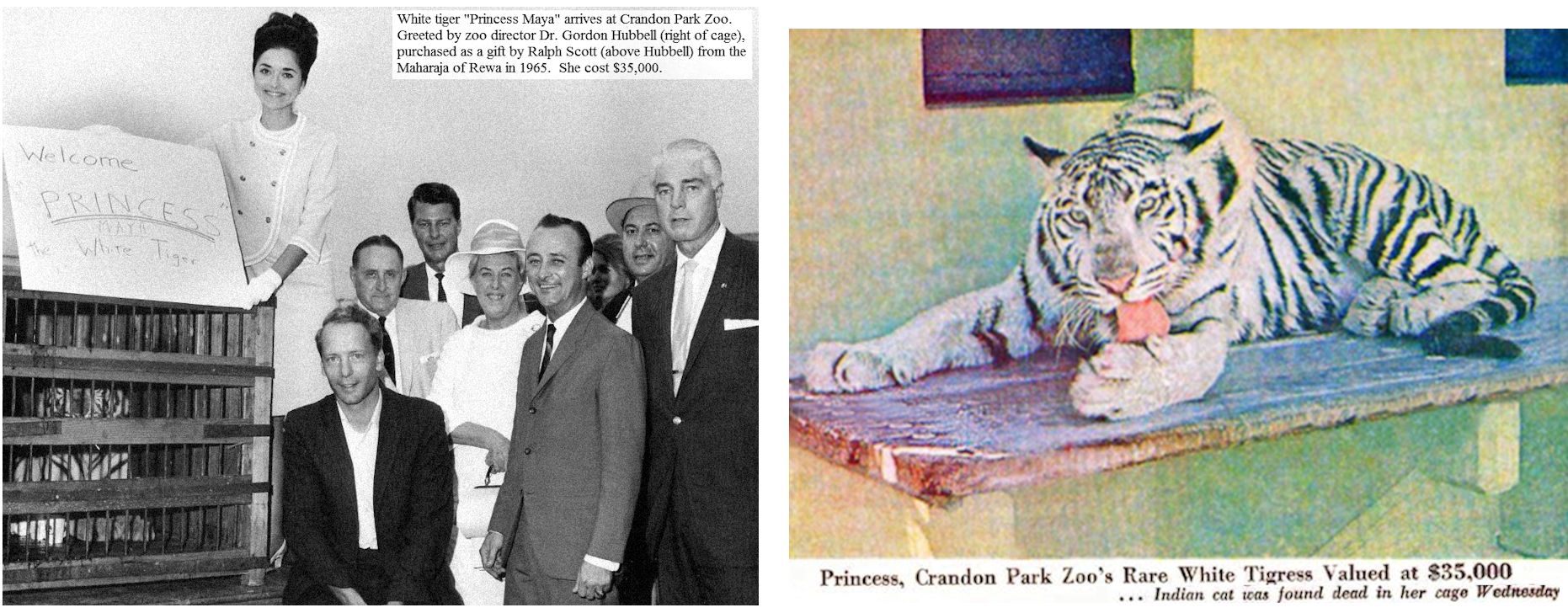
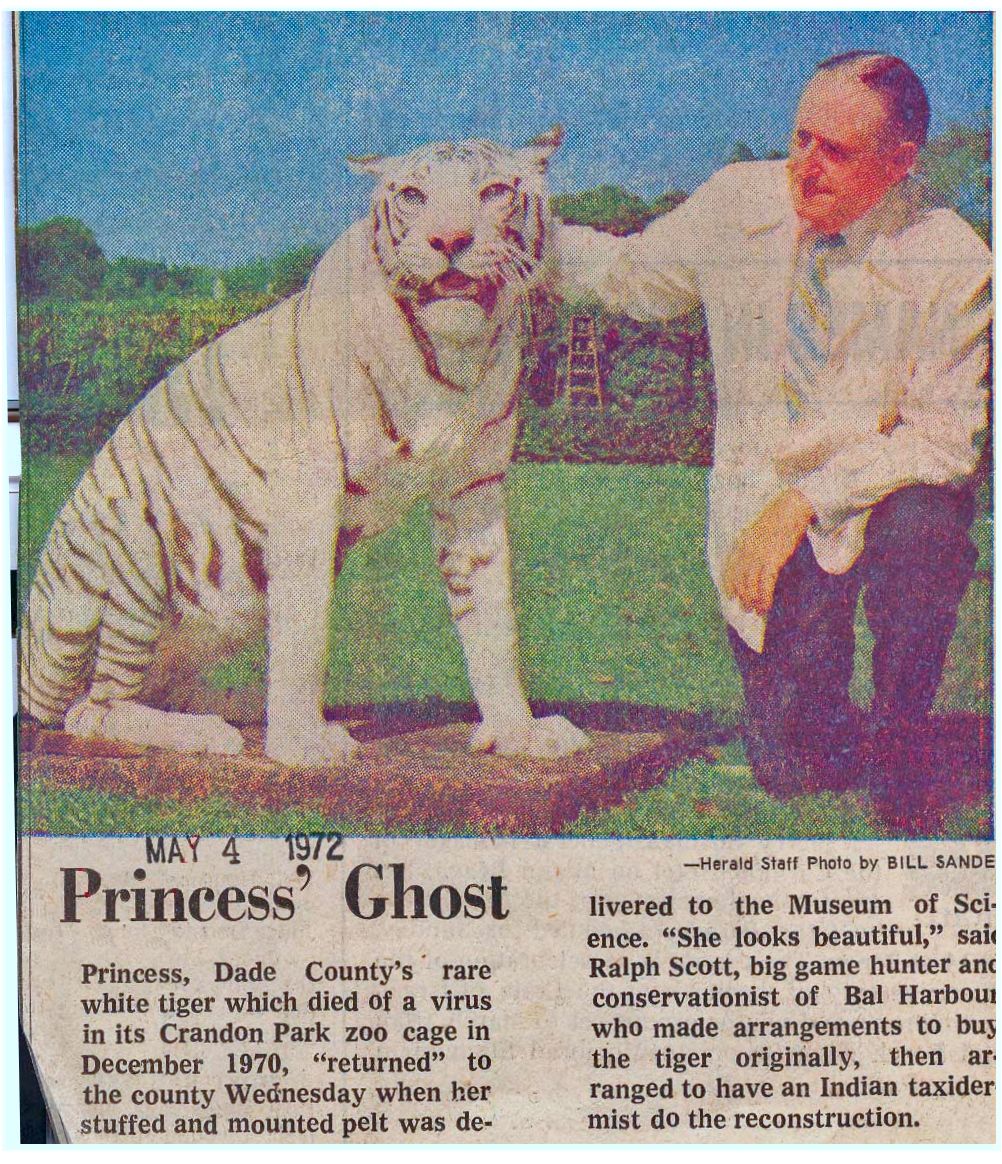
In 1970, Dalip, a white tiger from India, was temporarily exhibited at the India Pavilion at Expo 70, held in Osaka, Japan. He was described in Japanese as "sorai tora" and was viewed by around half a million people each day. Dalip was also exhibited in Budapest at the World Exhibition of Hunting as "what not to hunt". Previously white and tawny tigers had been hunted as trophies and up until 1965 it was legal to kill tigresses with cubs and to sell the cubs. A tiger called Gautam had been due to go to this event, but had died a week before the scheduled departure. Dalip was the only white tiger to return to India after exhibition in foreign lands (KS Sankahala, "Tiger!", chapter: The White Tigers of Rewa). In 1976, white tiger Virat died while his sale was being negotiated was in 1976.
Ivan M Henry of the Great London Circus ("George Matthews Great London Circus" owned by Sid Kellner) claimed that Julius Von Uhl's tigers Raja and Sheba II had 6 cubs, including 3 white cubs, in Waco, Texas in the Great London Circus in Spring 1975. A circus paper reported that von Uhl's Sheba II had three cubs on May 24th, 1975 in Fairfield, California which makes the birth date given for the litter of 6 impossible. Ivan Henry claimed to have successfully hand-reared the cubs. The tale of this supposed litter is at Circus White Tigers: The Mythical 1975 Litter of Six
Von Uhl's Raja and Sheba II had three cubs on June 27, 1976 at the Baltimore County Fair. The cubs were a white female, "Snowball," a white male "Baltimore County Fair," and an orange male, "Muhammea Ali" (Muhammad Ali's name is reported in The Honolulu Advertiser, 12th August 12, 1976 p 3, "Catch a tiger by the nose..."). According to von Uhl the two white cubs were put to sleep right away because of deformities. The orange cub was sold to Ringling Bros Circus at a cost of $20,000 each. Roychoudhury misidentified the white female, Snowball, as Maharani. Maharani was part of a later litter and went to performer Gunther Gebel-William and died in 1984; press reports allow me to correct that error. Newspaper articles show that Gebel-Williams's Maharani was born in 1978 and he acquired her in January 1979. Raja and Sheba II produced 3 white tiger cubs at Kingdom's 3, Stockbridge on Saturday June 18th, 1977. Kingdom's 3 was the 1976 incarnation of 1972's Lion County Safari in Stockbridge (between Atlanta and Macon), Georgia. Two didn't live long. In 1977, the surviving white female, Scarlett O'Hara, cut the ribbon at the opening of a hotel in Atlanta (this was the last article about von Uhl from the Atlanta area). The Orlando Sentinel, 16th August, 1977 (p 27) reported that a rare white tiger cub [Scarlett O’Hara] "from an attraction near Atlanta" was at the centre of Miss National Teenager. Scarlett O'Hara died on Jan 30th, 1978 at Grady Memorial Hospital's animal research clinic in Atlanta, while undergoing eye surgery to correct strabismus. She died of cardiac arrest under the anaesthesia.
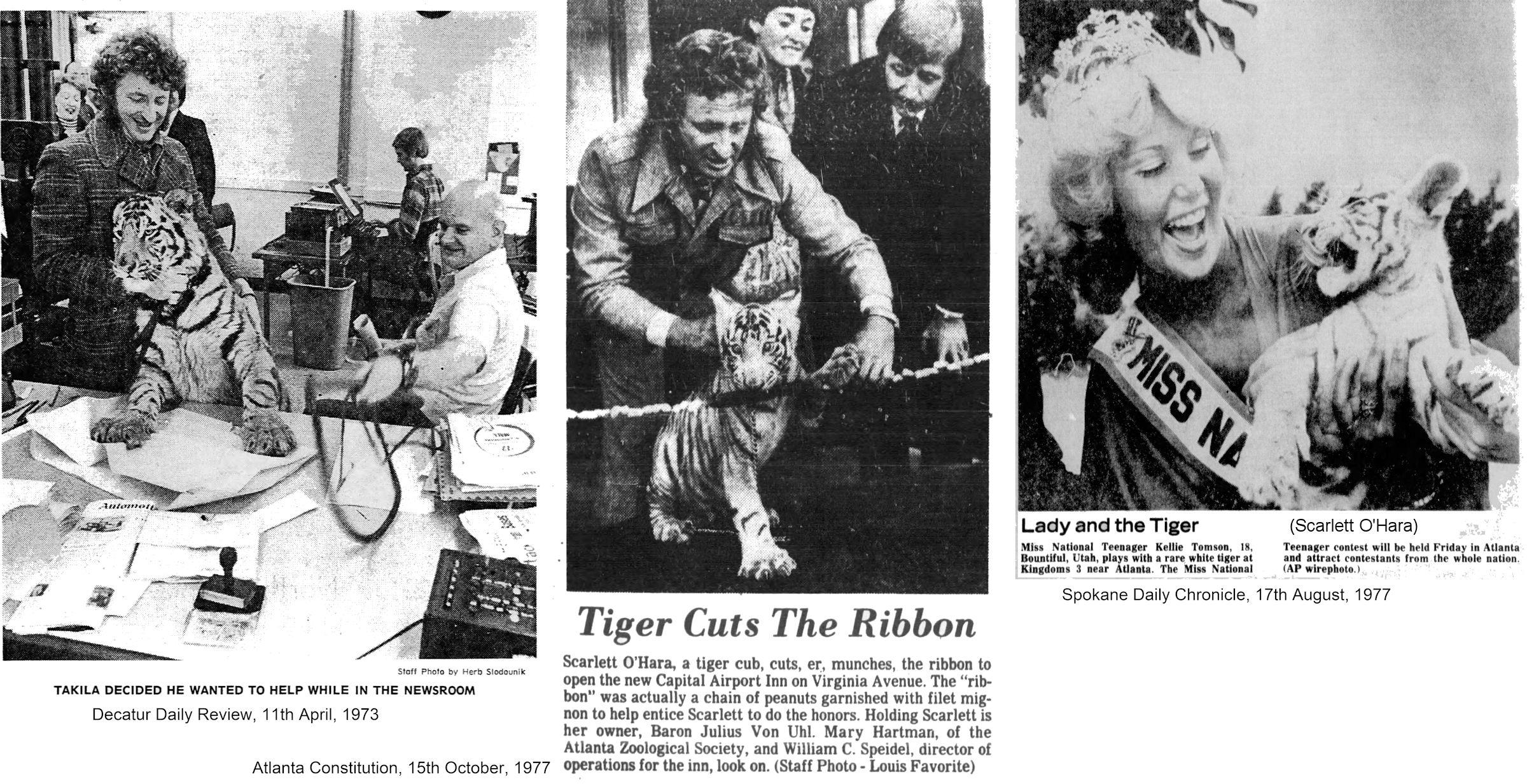
The Tampa Bay Times, St. Petersburg, Florida, 2nd July, 1977 Page 23 has a picture captioned "Kandy Jones with Tigger a rare white tiger cub." It says "And Kandy Jones from Gainesville a student at Auburn University is lavishing care on Tigger a rare white tiger cub born in Atlanta." Tigger was brought to the university (which is a veterinary college in Alabama) to be treated for an infection. This might be one of Scarlett O’Hara’s siblings born on 18th June, 1977. If so, the cub did not reach adulthood (infection around the umbilicus is relatively common, and often fatal). Von Uhl was the only person in the Western Hemisphere breeding white tigers in 1977-1979.
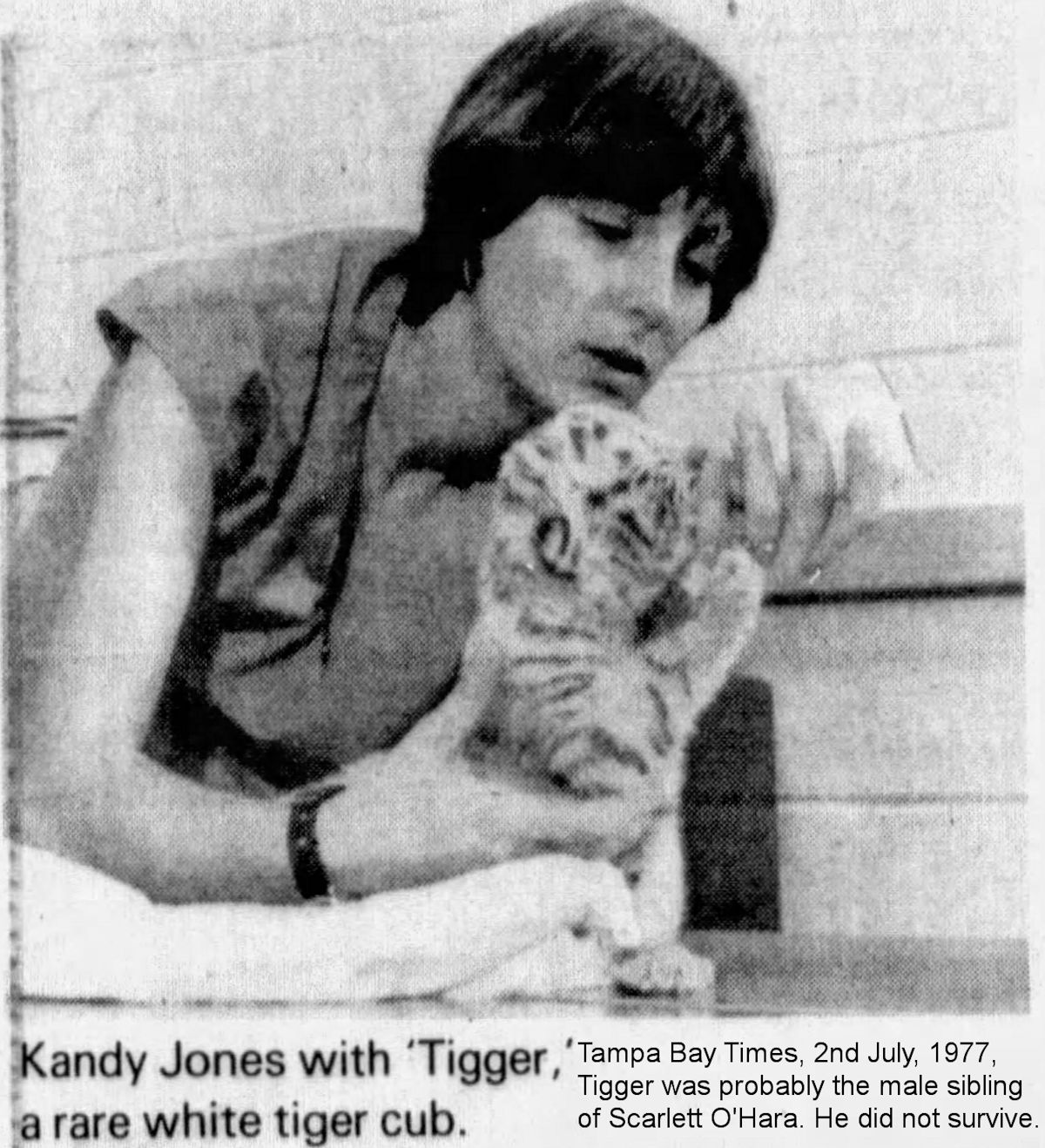
Kingdom's 3 closed in spring 1979. Maharani was Ringling's first performing white tiger.
Circus White Tigers: Takila/Chequila & Tony - Patriarch of a White Tiger Line; Maharanee/MaharaniBy way of coincidence, a litter with four white cubs, and one orange was born on 27th June, 1976, at the Cincinnati Zoo - it was fathered by Tony. Hence the three cubs born in Baltimore and the sire of those in Cincinnati (Tony) were all offspring of Raja and Sheba from the Sioux Falls Zoo.
The first white zoo tigers in Canada were in Montreal in 1976. The Montreal Gazette, 17th March, 1977 (p 3) mentioned five month old white tiger cubs in the Shrine Circus at the Montreal Forum. The article mentions 22 year old Wade Burck, and the cubs would have been 9 month old (not 5 month) cubs Ika and Ari.
The Honolulu Star-Bulletin, 17th February, 1980 (p 128) reported on White Gold, which it said was a $100,000 seven week old white tiger cub, with a Great Dane as a foster mother. White Gold was an orange heterozygote. His parents may have come from von Uhl’s stock, but White Gold’s place of birth isn’t mentioned.
Back in India, white tigers were loaned out to zoos for outcrossing and the government had to impose a whip when they refused to return either the white tigers or their cubs. School students in Madhya Pradesh now want to see white tigers back in Rewa. In 2007, the region had only one white tiger, which was in the zoo in the state capital (one of only 75 white tigers in India at the time). Pushpraj Singh, a scion of the Rewa royal family of Rewa wanted to keep white tigers at Govindgarh Lake Palace just as his father had kept Mohan.

THE WHITE BENGAL TIGERS OF ORISSA
A second strain of white tigers appeared in the Nandankanan Zoo in Orissa, India. When the first three white tigers of the Orissa strain were born, the Nandankanan Bio Park already had a white tiger named Diana (also called Subhra) from New Delhi Zoo. According to the Leipzig International Tiger Studbook (which is now the accepted one), the parents of Diana (#186) and Thiana (#187) are listed as Jim (#133) and Ashima (#116), which would make Jim heterozygous! In the Zoo Zen Studbook from the Zoo Outreach Organization, they list Diana's and Thiana's parents as Hari and Ashima (both white tigers), which considering the source, is more likely to be correct. A roadmap-sized genealogical chart of white tigers from New Delhi Zoo (sadly now lost) showed that Jim never had any white offspring. Jim is also discussed in K.S. Sankhala's book “Tiger,” again with no mention of him siring white cubs. The genealogy at Rewa shows Hari and Ashima breeding, which means the death-date shown for Hari in modern studbooks is incorrect. Wild-caught Jim (bred to Ratna) was infamous for swallowing a live cat whole which was why he was sent to live at the New Delhi Zoo.
The three white cubs at Nandankanan Zoo were born to a pair of orange tigers, Deepak and Ganga, in 1980 in the Nandankanan. The parents were unrelated to the Rewa white tigers. The produced 7 more cubs of which 2 were white. Although their full pedigree is unknown, it is assumed that a male grandparent of the white tigers carried the recessive white gene and passed this to his male offspring, Deepak. Deepak was then mated to his own daughter, Ganga, resulting in the white cubs. Nandankanan Biological Park went on to have the largest collection of white tigers in India, with 8 females and 5 males. A mating of Deepak with unrelated white tigress Diana produced a female called Aswini. Deepak and Ganga produced (between 1980 and 1981) females Alaka, Nanda and Jamuna, plus males Debabrata and Pinaki. Debabrata was outcrossed to white tigress Diana and produced (1983) females Sweta, Swapna, Sipra plus male Sangram and a male that died in infancy. Two more white cubs, a male and a female were produced in 1985.
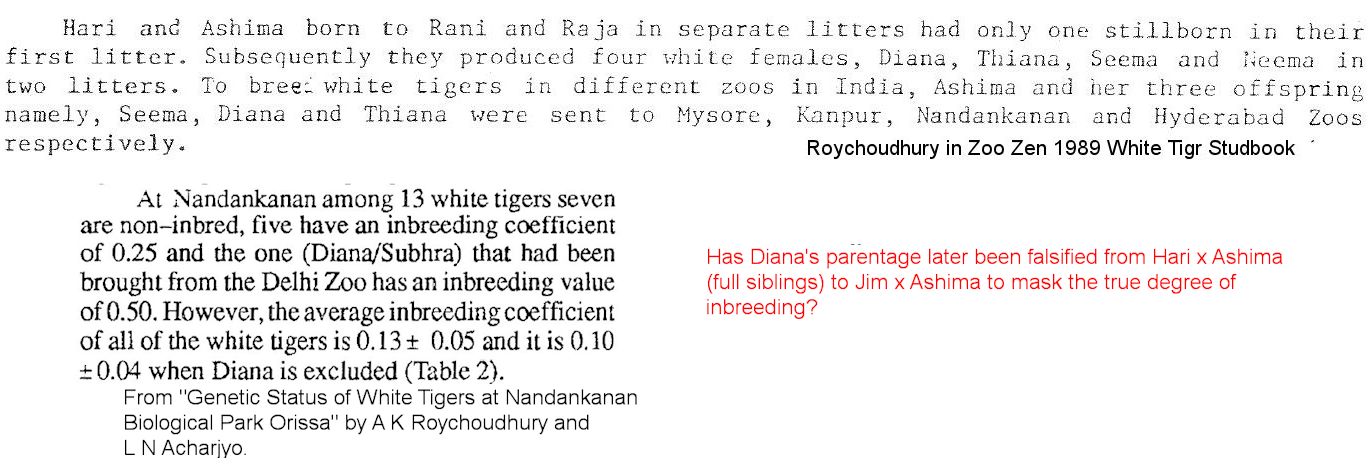
An article in The Statesman, Delhi, Jan 23, 1980 pg. 5 read New Dynasty Of White Tiger, Bhubaneswar, Jan. 22 - Three white tiger cubs were born last week in the Nandan Kaanan biological park, 15 km from here, reports PTI. The notable feature of these cubs is that they were born of two normal coloured Royal Bengal tigers, Deepak and Ganga, in a sanctuary. Their birth followed the arrival in Nandan Kanan of a white tiger, Subhra, from Delhi Zoo in exchange for two black leopards and two Royal Bengal tiger cubs. There are only 32 white tigers all over the world in various zoos. Of these 24 are in India. Almost all white tigers are the progeny of the famous white tiger, Mohan, belonging to the former Maharaja of Rewa. The birth of three white cubs in Nandan Kanan marks a dynastic departure.
Chart 02: White Tigers of Orissa Genealogy (large image, opens in new window)
Chart 02-1: Orissa Lines (Pseudo-Melanistic White Tigers) (large image, opens in new window)
Chart 02-2: Orissa Lines Aswini, Pinaki and Anand descendants
Chart 02-3: Orissa Lines Thara and Krishna descendants
Chart 02-4: Orissa Lines Moti II and Homa descendants
In Sri Chamarajendra Zoological Gardens, Mysore in 1984, a white female and an orange female were born to two orange tigers. The grandmother, Thara, was Deepak's sister acquired in 1972. Mysore Zoo also had white females Priyadarshini and Ashima, the latter obtained from Delhi Zoo. Calcutta Zoo bred its white tigers from 2 white males and an orange female bought from the Maharajah and also had white tigers born into their collection from another branch of the Nandankanan Zoo Orissa strain. The Orissa strain white tigers' genes have now apparently been lost.
12, possibly 13, tigers, including 7 white tigers died at at Nandankanan between 23rd June and 7th July 2000. At the time the zoo had 32 white and 24 orange tigers. After the outbreak of disease the zoo’s tiger population was reduced to 25 orange and 19 white tigers. According to The Times of India, 8th July 2000, the Chief Conservator of Forests, S.K. Patnaik, denied that the deaths had anything to do with the proliferation of tigers in captivity through inbreeding; the pedigrees of all tigers at Nandankanan were maintained and all efforts were made to avoid inbreeding. According to zoo records, the tragedy began on 23rd June 23. 2000, when an adult orange tiger named Debashish died. A post mortem indicated trypanosomiasis - a vector-borne parasitic infection endemic in the region. On 2nd Jul 2000, adult tiger Sagar showed similar symptoms and did not respond to an injection of the antibiotic Berenil. (Parija, SC and Bhattacharya, B. The Tragedy of Tigers: Lessons to Learn From Nandankanan Episode, Indian Journal of Medical Microbiology, (2001) 19 (3): 116-118.)
According to the Times of India report (8th July 2000) Nandankanan zoo had produced 300 tiger cubs - 177 orange and 123 white - since 1967, but few had survived, possibly because of weakening genes, though it did not back this up with numbers, ages or causes of death. During that period the zoo had sold or exchanged 33 orange and 22 white tigers to other Indian zoos, and 2 orange and 6 white tigers to foreign zoos. 300 cubs over 33 years = 9.1 cubs per year average. Nandankanan Zoo decreased its early mortality rate by not publicly exhibiting tigers until they reached 12 months old. The American Zoological Association SSP claim a 35% (approx. one third) tiger cub mortality rate in captivity (birth to 12 months old) and the Indian tiger studbook gives similar figures.
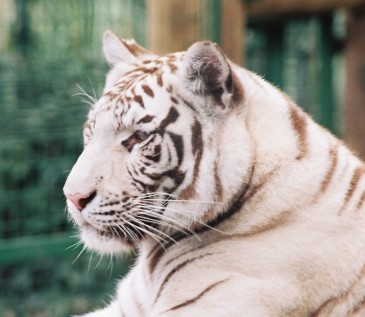
White Tiger at Paradise Wildlife Park |
Textual content is licensed under the GFDL.
Albino tigers (Cooch Behar)
Narayan, V. N. 1924. Number of cubs in a tiger’s litter. J. Bombay Nat. Hist. Soc., 28:1124.
Pocock RI, 1939. Fauna of British India, including Ceylon and Burma. Mammalia, vol. 1. Primates and Carnivora. Taylor and Francis Ltd., London, 464 pp.
White tigers (Orissa, Bilaspur, Rewa, Bhagalpoore, North Bengal, Assam and Korea)
Cuvier, Georges. 1832. The Animal Kingdom. G. & C. & H. Carvill.
D'Abreu EA. 1916. An Albino Tiger From The Central Provinces JBNHS, Vol XXIV, Pt IV, pg 819
Dunbar Brander AA. 1923. Wild Animals In Central India.
Evans Gordon (Capt). 1921. A White Tiger In Captivity (With A Photo). JBNHS, Vol. XXVII, Pt IV, pg. 932
Gee, E. P. 1959. Albinism and partial albinism in tigers. JBNHS., 56:581-587.
Lydekker, Richard. 1893. The Royal Natural History. Frederick Warne.
Mishra, Swati Wilderness Diagnosis, 2001: What Is the White Bengal Tiger's Future? Action BioScience.
Pant, M. M. & Dhariyal, I. D. (1979) : White tiger progeny, its economic potentialities. Indian Forester. Special issue on 1st International Symposium on tiger. New Delhi, 22nd-24th Feb. pp. 52-58.
Pocock RI, 1929. Tigers. J. Bombay Nat. Hist. Soc., 33:505-541.
Pocock RI, 1939. Fauna of British India, including Ceylon and Burma. Mammalia, vol. 1. Primates and Carnivora. Taylor and Francis Ltd., London, 464 pp.
Rathore, B. S. & Khera, S. S. (1979): Mortality in tigers in India. Paper presented in 1st International Symposium on tiger. New Delhi.
Roychoudhury, a. K. & Sankala, S. K. (1979) : Inbreeding in white tigers. Proc. Indian Acad, Sci. 8SB: 311-313.
Roychoudhury, A. K. (1980) : Is there any lethal gene in the tiger of Rewa? Curr. Sci. 49: 518-520.
Saharia, V. B. (1979) : Population dynamics in captive tigers. Wildlife News letter 7: 36-40.
Thornton, I. W. B., K. K. Yeung, and K. S. Sankhala. 1967. The genetics of the white tigers of Rewa. J. Zool. (London), 152:127-135.
Weigel, I. 1961. Das Fellmuster der wildlebenden Katzenarten und der Hauskatze in vergleichender und stammesgeschichtlicher Hinsicht. Säugetierk. Mitt., 9 (Sonderheft):1-120.
Genetics of Chinchilla and Albino
Robinson's Genetics for Cat Breeders & Veterinarians 4th Ed (the current version)FOOTNOTE
Most white tiger websites have a pro- or anti-agenda and variously claim to give “facts,” “truths” or debunk “myths” but give misinformation or have hidden agendas. I stick to facts and deductions based on facts. Some information is documented, some is from personal correspondence with zoos, and some is from the recollections or personal notes of people involved with circus or zoo tigers where records were have been lost or destroyed. Even the different editions of tiger studbooks are inconsistent. Information from my pages, which are frequently updated, is widely copied on those other sites. Some sites have tried to claim I copied their work.
|
BACK TO HYBRID & MUTANT BIG CATS INDEX |